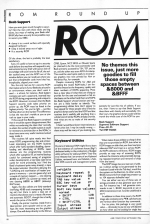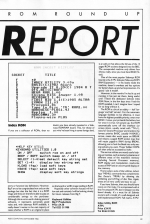
A&B Computing
 1st September 1986
1st September 1986
Categories: Review: ROM Chip
Author: Dave Reeder
Publisher: Supreme Software Support
Machine: BBC Model B
Published in A&B Computing 3.09
No themes this issue, just more goodies to fill those empty spaces between &8000 and &BFFF
Beeb Support (Supreme Software Support)
Have you ever given much thought to security? Not the men with thick necks and big boots, but ways of making your Beeb safe? BASICally there are only three possible ways to secure your BBC:
- clamp it to a work surface with specially designed hardware
- keep it locked away out of sight
- fit a security ROM
Of the three, the last is probably the least satisfactory.
Sure, it's useful to have to tap in a security code before the machine will respond to any instructions but any thief with just an inch of knowledge will soon have the lid off, the solder sucked away and the ROM out of the window before you can recall just where you put that unforgettable code word that has, inexplicably, slipped your mind.
No, the only real use for a security ROM that makes sense is if your Beeb sits around in an environment where you don't want it used - a school, for instance. Beeb Support contains just such a password, inserted into the ROM during programming and unique to the ROM. However, to ensure that the Beeb Support security code takes priority on power up, the ROM must be fitted in the highest priority. Yes, you're right - just like half the others on the market! The difference is that the rest don't warble at you as you rush to type in your code...
If this was all that Beeb Support contained then it would be a grave disappointment. But whilst not endorsing the claim that 'normally to obtain this number of useful routines it would be necessary to purchase four or five ROMs', it does have some very useful routines tucked away inside it.
The routines fall quite neatly into four areas: ROM, programming, disc and printer. Least interesting are the ROM routines which offer fairly standard disabling, downloading and identifying of ROMs. Least obvious are the programming routines which offer a graphics fill, an interval backup (useful for continued saving of programs under development), a key beep (said to be useful for word processing, but I find the Beeb's keyboard quite noisy already), a tape file locker/unlocker (therefore allowing the *LOADing and examination of header programs in memory - you can guess why) and a couple of memory zappers - one clearing &0300 to &7FFF (ie a power-up reset) and one clearing &8000 to &BFFF (sideways RAM area).
Again, the disc utilities are fairly standard (verifying, 40/80 track transposing, formatting etc) but there is quite a neat set of routines that allows you to create a file menu and automatic !BOOT, though this is hardly worth the price of the ROM.
Finally, the printer routines. Aside from a label printer, print spooler and so on, perhaps the most interesting are the graphics dumps. One will dump directly to the Shinwa CP80, Epson, NCC 8023 or Olivetti Spark Jet (claimed to be the most commonly used Beeb printers) accessed by SH, EP, and so on, and the other acts as an AMX Art dump. This could be used quite easily to incorporate graphics into text printed by View or Wordwise Plus, for example.
Despite reviewing ROMs for A&B and compiling the recent ROM Index, I am frequently amazed at the frequency, quality and sheer numbers of ROMs appearing. Most have a clear idea of what they are trying to provide for the user and succeed or fail on that basis; on the other hand there are ROMs like Beeb Support whose function and market are a little harder to identify. The programming utlities here don't appear to have appeal for those people who'd find the graphics dumps useful and the ROM and disc routines don't usefully add anything that a whole host of similar ROMs already provide. And what are we to make of this security aspect?
I think I would have fewer reservations at a lower price but I may be totally wrong - there may well be many of you looking desperately for just this mix of utilities. If you are, then I have to say that Beeb Support does them well, cleanly and successfully. On their own, the graphics dumps could well be worth the whole cost of the ROM to you.
Keyboard Utilities (Big F Productions)
Owners of sideways RAM might like to learn of the existence of a software house (Big F) dedicated solely to the production of budget utility software for sideways RAM. Their first two releases that I am aware of are Keyboard Utilities, reviewed here, and Sidekick, a Solidisk SWR control and management system.
What makes these utilities so cheap is that they are not provided on ROM, but rather as ROM images on disk that you then load into sideways RAM and treat as a service ROM. As ROM collectors will know, ROM images provide an easy way of accessing ROMs without the tiresome and potentially damaging repeated insertion and removal of chips from the board.
This ROM image has one main set of utilities: it allows strings to be generated via the keyboard (used with the Tab key), much like the system on the Electron. In other words, BASIC keywords from single key presses - up to 104 separate definable keys!
You can either use any of three sets of strings provided or else generate your own set. For instance key I will generate commands in set 1, BASIC keywords in set 2, 6502 mnemonics in set 3 and be undefined in set 4.
In addition to these time savers, the ROM image also contains some *FX call shortcuts and various other function key commands.
For its price, this package is very good value - obviously its use to you will depend on how often you're looking for single key entry or function key definitions. However, Big F are to be congratulated not only on the package but also the fact that it is a ROM image and they are therefore able to pass on considerable savings to the purchaser.
Although this is not an earth-shaking piece of software, it represents extremely good value and, with sideways RAM available, it really doesn't matter in the vast majority of cases whether a ROM is an original in place on the board or an 8K image residing in RAM.
Hopefully other software houses will follow suit and certainly I will be looking closely for future releases from Big F.
Index ROM (ATPL)
If you are a collector of ROMs, then no doubt you have already invested in a Sideways ROM/RAM board. This, for those of you who've been living in some foreign land, is an add-on that allows the full use of the 15 paged ROM sockets designed into the BBC.
The unexpanded machine only allows four (three, really, since you must have BASIC fitted).
One of the most popular Sideways ROM boards is the ATPL Sidewise (Sideways ROM/RAM Expansion) - it fits neatly inside the machine, doesn't overheat and has options for battery back-up and write protection. It's good; I use it myself.
However, in the months I've had it up and running, it has just sat there, being useful, until I fitted this dedicated Sidewise Index ROM. Now, in the few days since I had this ROM installed, I can't imagine how I coped for so long without it.
The ROM is a bit of an oddity - half 'language' and half 'service'. For the automatic language facilities to be effective, it must have the highest possible priority, even over BASIC. I know, you've heard this before, but for once it is true. On power-up, the ROM automatically turns off the interlace (or screen jitters, usually cured with *TV n,1!), tests for Second Processor and transfers the lowest priority BASIC (usually Hi-BASIC) across, resets disc work space on BREAK and retains a paged ROM socket map that will retain paged-in RAM during BREAK, allowing you to fool the Beeb into only seeing sockets you want. These 'hidden' ROMs can then only be accessed by Index.
The service utilities are mostly useful tidying-up routines, such as memory clearance of different areas of the machine's memory (including Second Processor memory), ROM display and manipulation, read/write access of RAM and an uncorrupted display of low memory.
There is also a suite of disc utilities, including a *MENUL command that complements Disc Doctor's *MENU by allowing the LOADing and LISTing of disc files. Again, these are all very useful and easy to use.
If you have Sidewise, then you should leave room on it for Index. I'm so impressed with it that I'm amazed ATPL don't release it on the board already. It's a must for all Sidewise owners and a model of a well-designed and well-implemented ROM. Full marks, ATPL!
Other BBC Model B Game Reviews By Dave Reeder
This article was converted to a web page from the following pages of A&B Computing 3.09.













